engine YAMAHA VX-C 2021 Bruksanvisningar (in Swedish)
[x] Cancel search | Manufacturer: YAMAHA, Model Year: 2021, Model line: VX-C, Model: YAMAHA VX-C 2021Pages: 214, PDF Size: 4.23 MB
Page 19 of 214
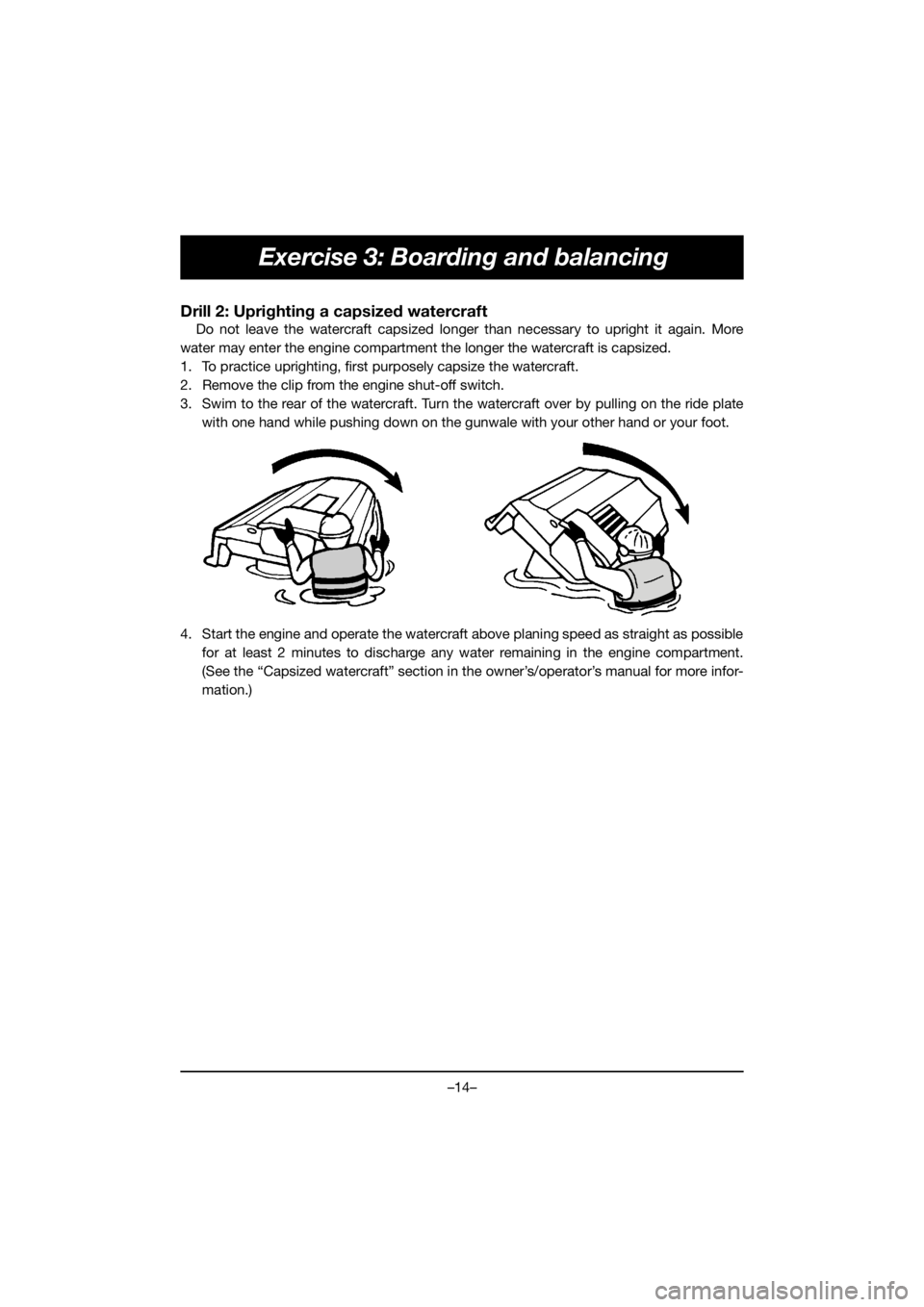
–14–
Exercise 3: Boarding and balancing
Drill 2: Uprighting a capsized watercraft
Do not leave the watercraft capsized longer than necessary to upright it again. More
water may enter the engine compartment the longer the watercraft is capsized.
1. To practice uprighting, first purposely capsize the watercraft.
2. Remove the clip from the engine shut-off switch.
3. Swim to the rear of the watercraft. Turn the watercraft over by pulling on the ride plate with one hand while pushing down on the gunwale with your other hand or your foot.
4. Start the engine and operate the watercraft above planing speed as straight as possible for at least 2 minutes to discharge any water remaining in the engine compartment.
(See the “Capsized watercraft” section in the owner’s/operator’s manual for more infor-
mation.)
F4N-70-forPrint.book Page 14 Tuesday, October 6, 2020 9:08 AM
Page 20 of 214
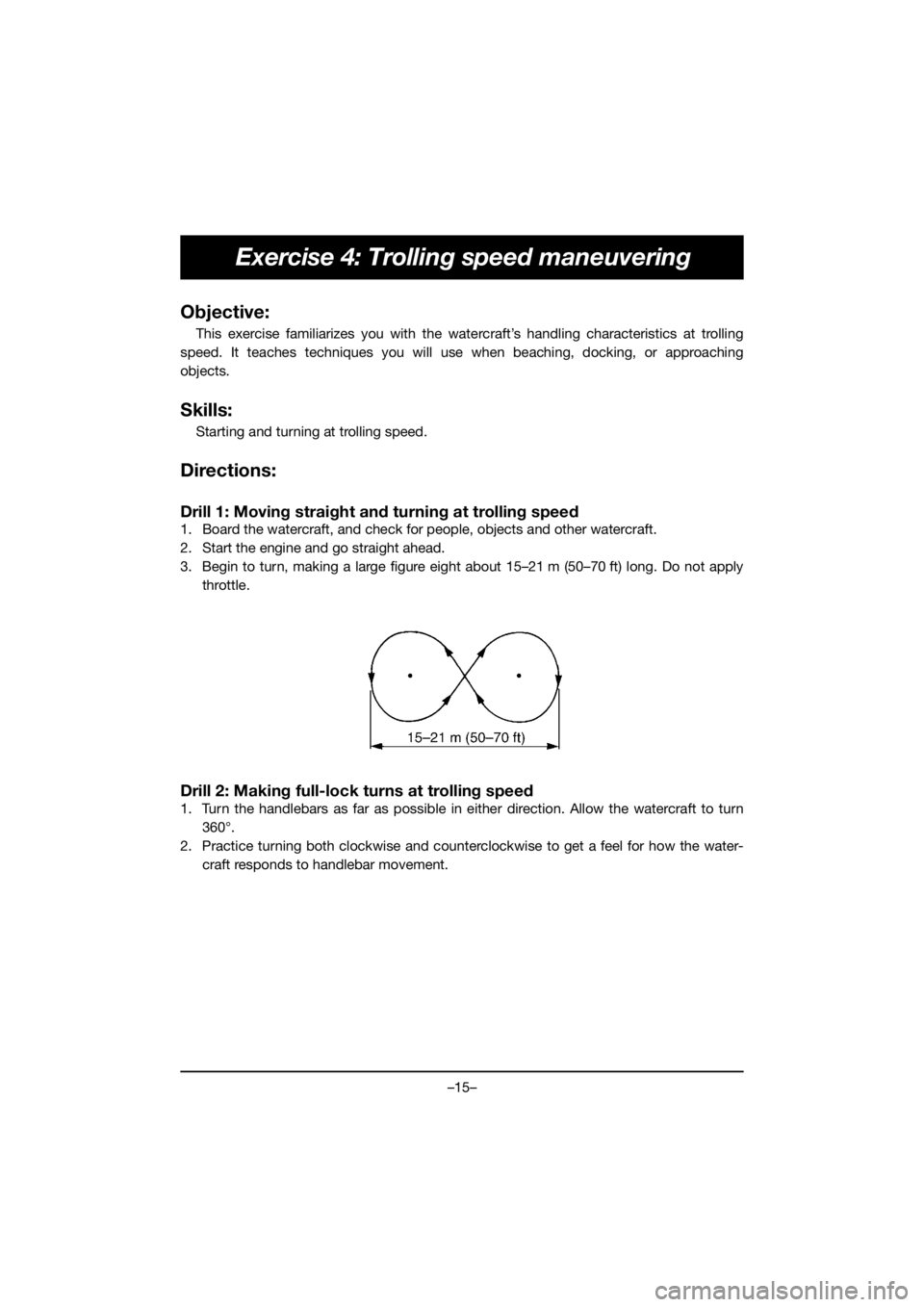
–15–
Exercise 4: Trolling speed maneuvering
Objective:
This exercise familiarizes you with the watercraft’s handling characteristics at trolling
speed. It teaches techniques you will use when beaching, docking, or approaching
objects.
Skills:
Starting and turning at trolling speed.
Directions:
Drill 1: Moving straight and turning at trolling speed
1. Board the watercraft, and check for people, objects and other watercraft.
2. Start the engine and go straight ahead.
3. Begin to turn, making a large figure eight about 15–21 m (50–70 ft) long. Do not apply throttle.
Drill 2: Making full-lock turns at trolling speed
1. Turn the handlebars as far as possible in either direction. Allow the watercraft to turn360°.
2. Practice turning both clockwise and counterclockwise to get a feel for how the water- craft responds to handlebar movement.
F4N-70-forPrint.book Page 15 Tuesday, October 6, 2020 9:08 AM
Page 22 of 214
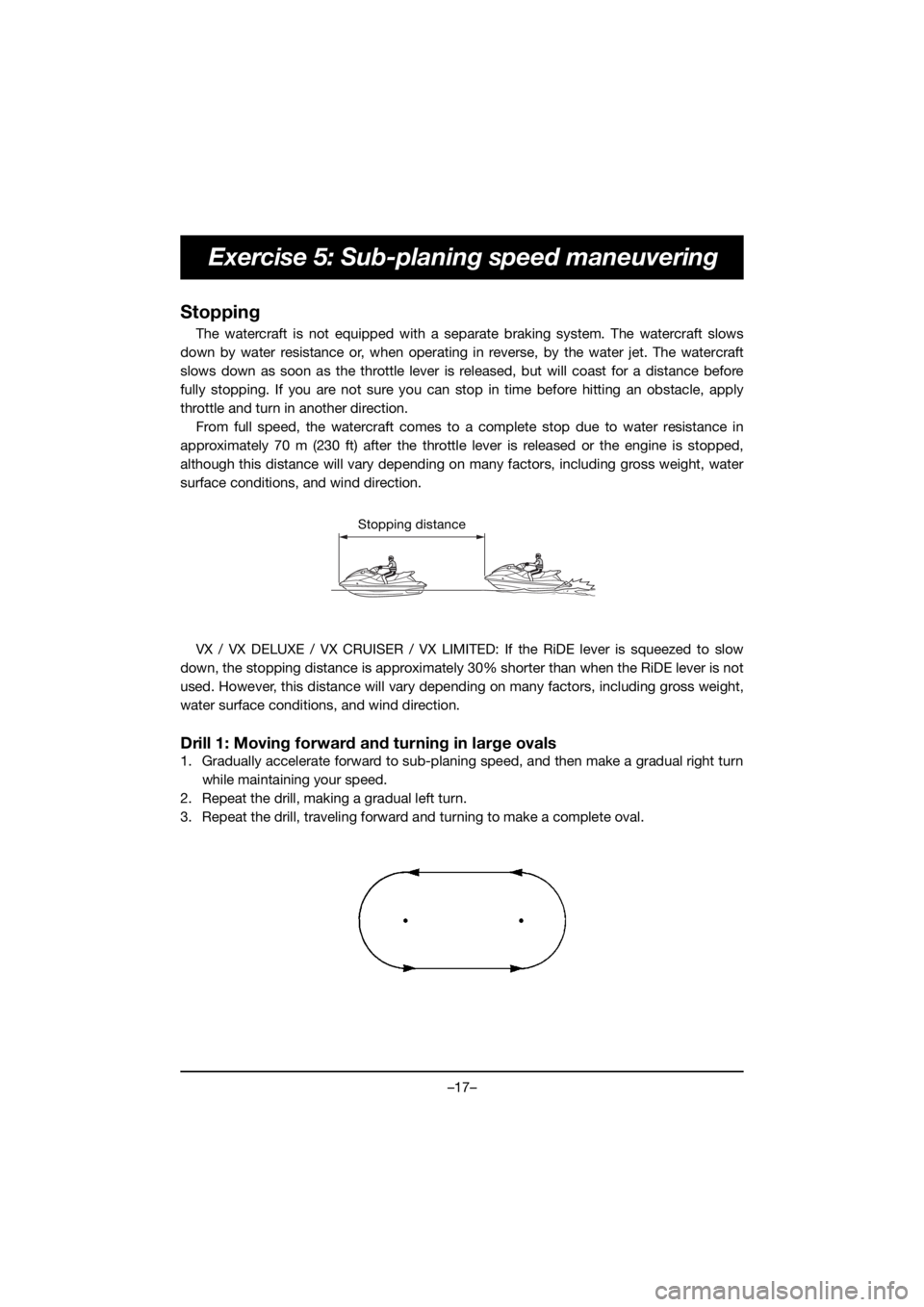
–17–
Exercise 5: Sub-planing speed maneuvering
Stopping
The watercraft is not equipped with a separate braking system. The watercraft slows
down by water resistance or, when operating in reverse, by the water jet. The watercraft
slows down as soon as the throttle lever is released, but will coast for a distance before
fully stopping. If you are not sure you can stop in time before hitting an obstacle, apply
throttle and turn in another direction. From full speed, the watercraft comes to a complete stop due to water resistance in
approximately 70 m (230 ft) after the throttle lever is released or the engine is stopped,
although this distance will vary depending on many factors, including gross weight, water
surface conditions, and wind direction.
VX / VX DELUXE / VX CRUISER / VX LIMITED: If the RiDE lever is squeezed to slow
down, the stopping distance is approximately 30% shorter than when the RiDE lever is not
used. However, this distance will vary depending on many factors, including gross weight,
water surface conditions, and wind direction.
Drill 1: Moving forward and turning in large ovals
1. Gradually accelerate forward to sub-planing speed, and then make a gradual right turn while maintaining your speed.
2. Repeat the drill, making a gradual left turn.
3. Repeat the drill, traveling forward and turning to make a complete oval.
Stopping distance
F4N-70-forPrint.book Page 17 Tuesday, October 6, 2020 9:08 AM
Page 23 of 214
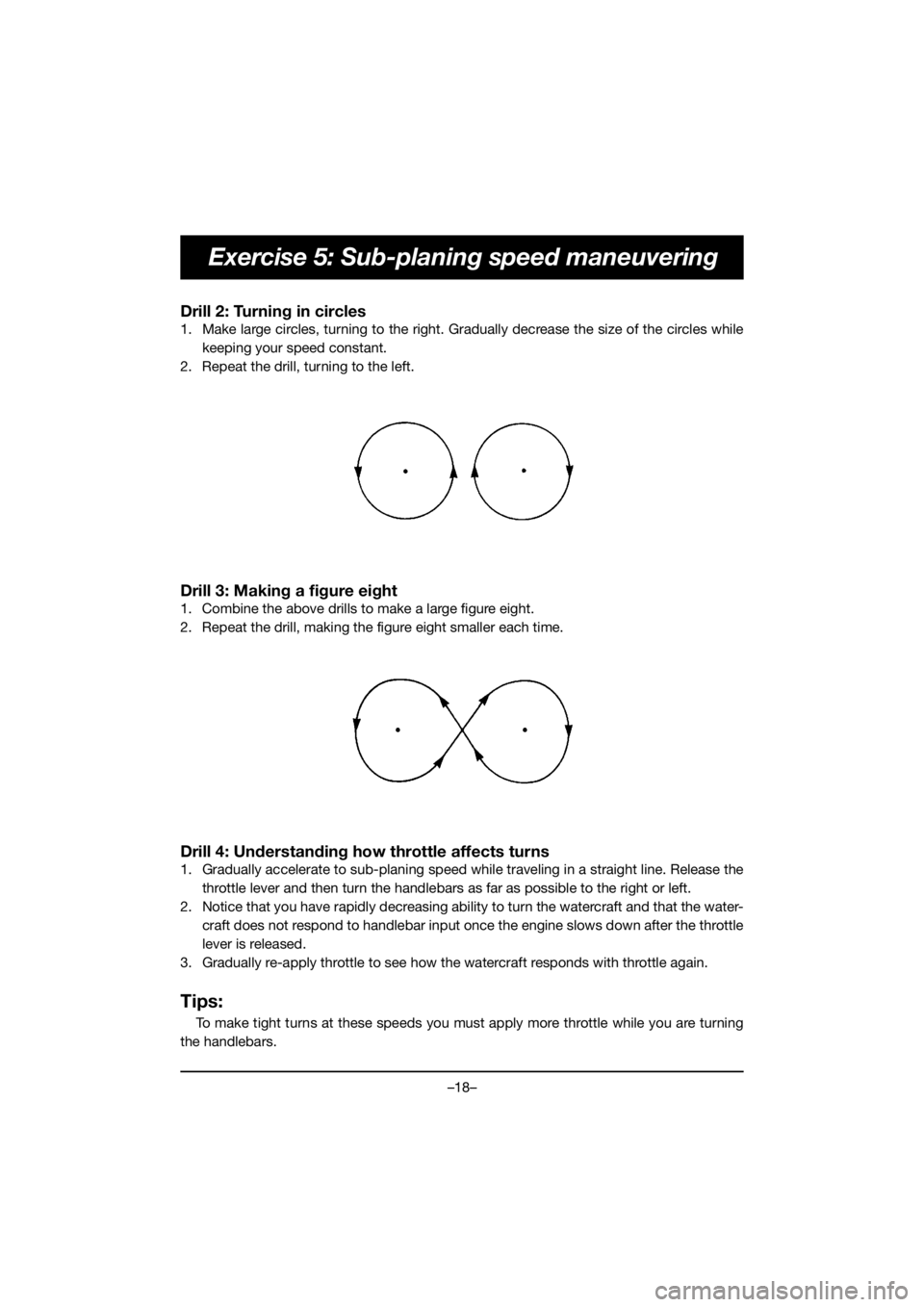
–18–
Exercise 5: Sub-planing speed maneuvering
Drill 2: Turning in circles
1. Make large circles, turning to the right. Gradually decrease the size of the circles whilekeeping your speed constant.
2. Repeat the drill, turning to the left.
Drill 3: Making a figure eight
1. Combine the above drills to make a large figure eight.
2. Repeat the drill, making the figure eight smaller each time.
Drill 4: Understanding how throttle affects turns
1. Gradually accelerate to sub-planing speed while traveling in a straight line. Release the throttle lever and then turn the handlebars as far as possible to the right or left.
2. Notice that you have rapidly decreasing ability to turn the watercraft and that the water- craft does not respond to handlebar input once the engine slows down after the throttle
lever is released.
3. Gradually re-apply throttle to see how the watercraft responds with throttle again.
Tips:
To make tight turns at these speeds you must apply more throttle while you are turning
the handlebars.
F4N-70-forPrint.book Page 18 Tuesday, October 6, 2020 9:08 AM
Page 24 of 214
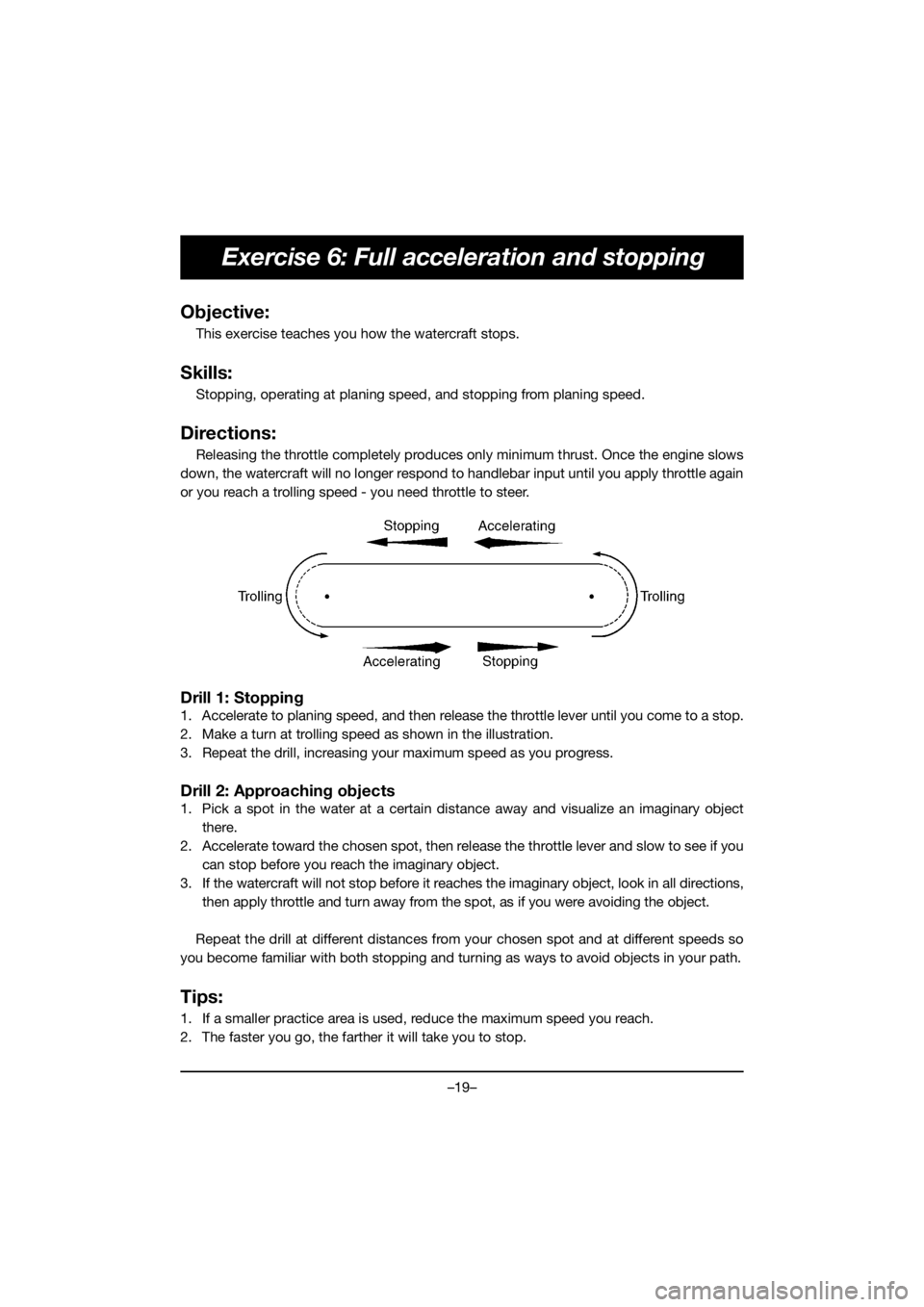
–19–
Exercise 6: Full acceleration and stopping
Objective:
This exercise teaches you how the watercraft stops.
Skills:
Stopping, operating at planing speed, and stopping from planing speed.
Directions:
Releasing the throttle completely produces only minimum thrust. Once the engine slows
down, the watercraft will no longer respond to handlebar input until you apply throttle again
or you reach a trolling speed - you need throttle to steer.
Drill 1: Stopping
1. Accelerate to planing speed, and then release the throttle lever until you come to a stop.
2. Make a turn at trolling speed as shown in the illustration.
3. Repeat the drill, increasing your maximum speed as you progress.
Drill 2: Approaching objects
1. Pick a spot in the water at a certain di stance away and visualize an imaginary object
there.
2. Accelerate toward the chosen spot, then release the throttle lever and slow to see if you can stop before you reach the imaginary object.
3. If the watercraft will not stop before it reach es the imaginary object, look in all directions,
then apply throttle and turn away from the spot, as if you were avoiding the object.
Repeat the drill at different distances from your chosen spot and at different speeds so
you become familiar with both stopping and turning as ways to avoid objects in your path.
Tips:
1. If a smaller practice area is used, reduce the maximum speed you reach.
2. The faster you go, the farther it will take you to stop.
F4N-70-forPrint.book Page 19 Tuesday, October 6, 2020 9:08 AM
Page 29 of 214
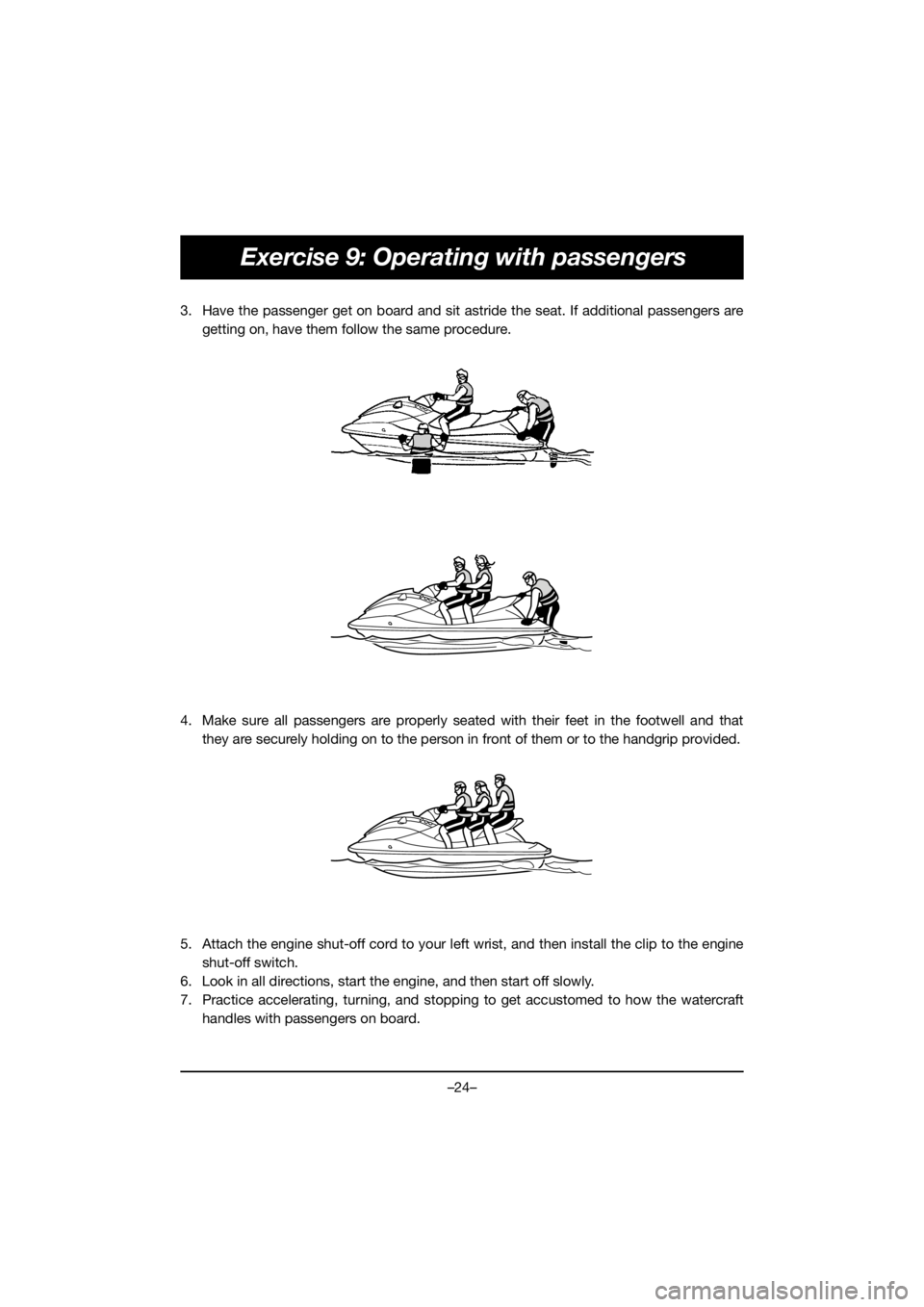
–24–
Exercise 9: Operating with passengers
3. Have the passenger get on board and sit astride the seat. If additional passengers aregetting on, have them follow the same procedure.
4. Make sure all passengers are properly seated with their feet in the footwell and that they are securely holding on to the person in front of them or to the handgrip provided.
5. Attach the engine shut-off cord to your left wrist, and then install the clip to the engine shut-off switch.
6. Look in all directions, start the engine, and then start off slowly.
7. Practice accelerating, turning, and stopping to get accustomed to how the watercraft handles with passengers on board.
F4N-70-forPrint.book Page 24 Tuesday, October 6, 2020 9:08 AM